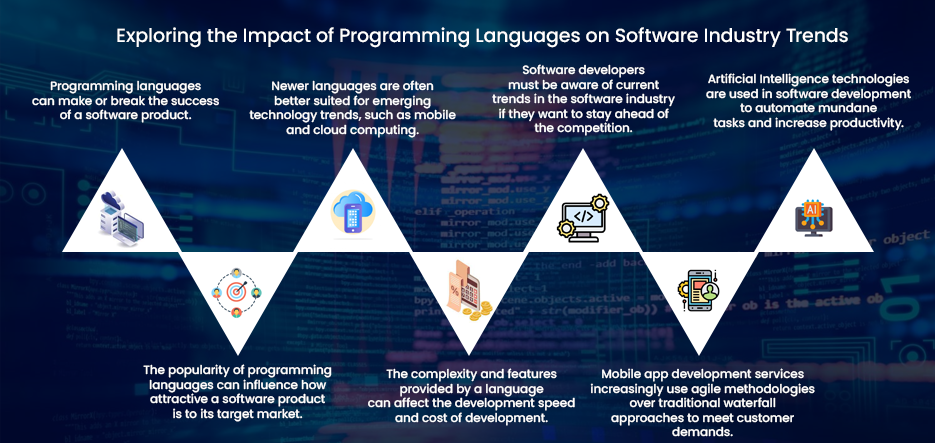Table of Contents
The Future of the software development industry is heavily dependent on the programming languages utilized in the development process. As per a report from Forbes, “Almost 80% of engineers are involving something like one language as a feature of their software development workflow”. In 2020, the most broadly utilized programming language was Ruby, trailed by JavaScript and Java.
Oxford Financial aspects saw that “programming language capability is turning out to be increasingly significant for employers, with more than 40% of companies anticipating that their staff should be capable in no less than one programming language”. Meanwhile, Infosys saw that as “almost 75% of IT professionals accept that understanding a wide assortment of the best programming languages for software development is vital to remaining competitive in the software development industry”.
Gartner likewise noticed that “Software development groups are zeroing in on the requirement for speed and agility, with a solid accentuation on programming language capability to assist with meeting these requirements.” This is reflected in the way that “the quantity of designers utilizing numerous programming languages has increased by 8% beginning around 2019“.
This has resulted in a greater interest in engineers with cutting-edge coding abilities and a comprehension of different languages. Companies are likewise searching for designers who have an eye for detail and can distinguish potential bugs quickly, which requires engineers to have exhaustive information on a wide variety of programming languages.
What are the Unique Scenes of Programming Languages?
The unique scene of programming languages is a continually moving scene of different languages and innovations. It comprises different programming language ideal models, for example, object-arranged programming, functional programming, rationale programming, scripting, and domain-explicit languages. Other programming languages give their unique features and benefits for different sorts of utilization. Instances of a few famous, powerful languages incorporate JavaScript, Ruby, and PHP.
What are the Jobs of Programming Languages in Present-day Software Development?
Nowadays, programming languages are playing a fundamental part in software development. It gives the ability to create algorithms and architectures for software, which structure the underpinning of current software development. Programming languages are additionally significant for correspondence among engineers and clients. In this part, we will talk about the job of programming languages in current software development.
1. Increased Productivity and Quality
Programming languages can be utilized to increase the productivity and quality of software applications. They provide a system that permits engineers to construct applications quickly while guaranteeing that they adhere to coding norms and industry best practices. The best programming language for game development assists them with creating more reliable and practical applications in programming languages in present-day software development.
2. Increased Productivity
Programming languages have additionally turned into an essential apparatus concerning increasing the productivity of software development. By utilizing solid libraries and structures, designers can create quicker applications with less code, setting aside time and cash for their organizations. Furthermore, these libraries and facilities permit designers to foster applications that are more hearty and reliable than at any time in recent memory.
3. Better Client Experience
Programming languages have likewise made it simpler to create easy-to-understand software applications. By utilizing the correct terminology, designers can, without much of a stretch, create intelligent UIs that are intuitive and simple to use. Custom software development companies in USA help ensure that clients are ready to quickly comprehend how to utilize an application, making it more straightforward for them to capitalize on it.
4. Further developed Upkeep
Programming languages permit designers to keep up with applications quickly, allowing them to fix any bugs or security issues that might emerge soon. By utilizing programming languages, engineers can undoubtedly recognize problems and make changes to the software without having to invest an excess of energy in debugging. This ensures that applications are ready to run as expected and proficiently for clients over an extensive period.
5. Upgraded Security
Programming languages can likewise assist designers with upgrading the security of their applications. By utilizing best practices and secure coding strategies, designers can create applications that are hard to breach or exploit. Furthermore, programming languages likewise give a scope of integral assets that permit engineers to distinguish and prevent potential vulnerabilities in their software. This guarantees that applications are essentially as secure as workable for clients.
6. Quicker Development Times
Programming languages have empowered designers to create applications in a small part of the time they would adopt traditional development strategies. This is because programming languages permit designers to quickly code and troubleshoot applications without having to invest a lot of energy in debugging or physically fixing any issues that might emerge.
7. More Flexibility
Programming languages likewise furnish designers with increased flexibility in software development. By utilizing present-day programming languages, engineers are ready to change existing applications quickly or create custom answers for their clients. Types of programming languages permit them to fit the software application to the particular necessities of their clients, ensuring that they can take advantage of their items.
8. Reusability
Programming languages likewise offer engineers the ability to reuse code. This can save them a great deal of time and cash, as they only need to invest energy in writing a similar principle with preparation. Furthermore, programming languages make it simple for engineers to share their codes with different designers, permitting them to cooperate on projects more quickly.
Crafting Excellence in Every Code! Partner with Us for Custom Software Brilliance!
Top 10 Programming Languages Shaping The Future Of Software Development in 2025
Software development is a constantly advancing cycle, and this has been particularly evident in the previous 10 years. Specifically, there has been a tremendous shift towards open-source software development, which has permitted developers to make powerful devices that can be utilized in various ways. In that capacity, it is critical to keep up to date with the most recent programming languages to be a fruitful software engineer. In this article, we will investigate the top 10 programming languages shaping the Future of software development in 2025.
1. Python
An open-source programming language that is utilized across different enterprises, for example, AI, artificial reasoning, web development, and information science. On account of its primary language structure, which makes it simple to learn and utilize.
2. TypeScript
TypeScript is an open-source programming language developed by Microsoft. It is a superset of JavaScript and has been intended to empower developers to compose huge-scope applications easily. Furthermore, TypeScript likewise gives highlights like type inference, generics, and async functions, which make it more potent than traditional JavaScript.
3. Go
A cutting-edge programming language developed by Google for building profoundly scalable and performant applications. Additionally gives support to digital transformation companies in USA, which permits developers to compose applications that can deal with various errands at the same time. Finally, it is open-source and can be utilized on different platforms.
4. Rust
Rust is a programming language developed by Mozilla for composing profoundly secure and solid applications. It is memory-safe, which makes it hard for programmers to take advantage of any weaknesses in your code. Rust additionally has areas of strength for well-being, making it more straightforward for developers to find and fix mistakes in their code. Furthermore, Rust can be utilized on different hardware platforms like ARM, x86, and x86-64.
5. Kotlin
Kotlin is a cutting-edge programming language developed by JetBrains for composing robust and secure applications. It is an object-oriented language that upholds both static and dynamic composing. Moreover, artificial intelligence in software development additionally gives highlights like type inference, generics, and valuable programming, which makes it simpler to compose complex projects rapidly. Besides, Kotlin is interoperable with Java, which makes it more straightforward for developers to move their current codebase to the new language.
6. Scala
Scala is a cutting-edge programming language developed by Martin Odersky for composing applications of enormous scope. It upholds both object-oriented and practical programming ideal models, which makes it reasonable for a large number of utilizations. Moreover, Scala additionally gives elements like type inference, generics, and example matching, which makes the best programming language for game development simpler to compose complex code.
7. Elixir
Elixir is a cutting-edge programming language developed for composing circulated and simultaneous applications. It is based on the Erlang VM, which gives elements, for example, message passing, adaptation to non-critical failure, and hot code overhauls. Besides, Elixir additionally offers highlights, for example, macros and example matching, which make it more straightforward to compose code.
8. JavaScript
JavaScript is the most well-known programming language on the planet. It is involved across various custom software development companies in USA for web development, versatile development, and game development, and that’s just the beginning. It highlights, for example, dynamic composing, object-oriented programming, and prototypal legacy. Which makes it a powerful language for making complex client-side applications.
9. Swift
A programming language developed by Apple to make powerful applications for both macOS and iOS. Likewise gives highlights like type inference, generics, and discretionary binding. Which makes it simpler to compose code rapidly and precisely. Furthermore, It is open-source and can be utilized on different platforms.
10. Clojure
Clojure is a cutting-edge programming language developed by Rich Hickey for building robust, circulated, and scalable applications. It is a powerful language that highlights, for example, constant information structures and unchanging qualities, making it reasonable for composing complex code rapidly. Furthermore, Clojure likewise upholds utilitarian programming ideal models, permitting developers to write applications more proficiently. It is likewise interoperable with Java, making it more straightforward to relocate existing codebases.
Empower Your Business with Cutting-Edge Software. Request a Free Consultation Today!
How do Programming Languages Influence and Drive Trends Inside the Software Industry?
Programming languages are the groundwork of the software industry, assuming an essential part in driving trends and development inside the sector. With many programming languages accessible today, developers have a wide assortment of choices to browse. While making software applications and projects. Every language offers its remarkable highlights and benefits for enterprise software development companies, making them profoundly pursued by developers for various purposes.
Notwithstanding individual languages being famous, specific trends inside the software industry are frequently driven by programming languages. For instance, Python is turning out to be progressively famous for its capacity to deal rapidly with information and make web applications accessible and easy to understand. Essentially, JavaScript is turning out to be perpetually well-known for making intuitive UIs and versatile applications. As these two languages become more well-known, developers are utilizing them more to make applications and projects. This is driving the software industry, all in all, in a specific bearing.
Programming languages likewise influence trends inside the software industry by giving developers better apparatuses and frameworks than ever. These instruments and frameworks frequently empower developers to make applications quicker. All the more effectively, prompting expanded efficiency inside the industry. As these instruments emerge, developers can rapidly adjust and utilize them to make imaginative applications.
By and large, programming languages play a significant part in driving trends and advancement inside the software industry. As developers keep on embracing new advances and apparatuses. They will affect how the industry develops and what heading it takes from now on.

What are the Popularity Metrics and Adoption Rates of the Featured Programming Languages?
With regard to surveying the popularity of programming languages, there are different variables to consider. Popularity metrics incorporate utilization insights, work postings, and web crawler inquiries. The accompanying article gives an outline of the popularity metrics and adoption rates for some famous programming languages.
1. Python
Python is one of the most well-known programming languages available, with utilization measurements. Showing that it is used by nearly 8 million developers around the world. It likewise has many work postings and web crawler question numbers, making it a profoundly sought-after language for fintech software development companies. Subsequently, Python has seen an adoption pace of nearly half.
2. Java
Java is one more generally utilized programming language, with use measurements showing that it is operated by north of 10 million developers around the world. It likewise has many work postings and web index inquiry numbers, making it an extremely well-known language for developers. The broad libraries and frameworks accessible for Java have driven its adoption rate to around 60%.
3. JavaScript
JavaScript is one of the most well-known languages for making intelligent UIs and portable applications. It has utilization measurements showing that it is utilized by more than 6 million developers around the world. As well as high work postings and web crawler question numbers. Its adoption rate is around 40%.
4. Ruby
Ruby is one of the more well-known programming languages, which has become popular because of its system, Rails. Measurements show that more than 1 million developers utilize the language around the world, and occupation postings for the language stay solid. Furthermore, the best custom software development companies’ inquiries for the language are high. Ruby’s broad libraries and frameworks have driven its adoption rate up to around 30%.
5. Go
Go is a somewhat new language. However, it has acquired a ton of popularity over the most recent couple of years. Use measurements show that it is utilized by nearly 2 million developers around the world, and occupation postings for the language stay solid. Furthermore, web crawler inquiries for the language are high. Its adoption rate is around 25%.
What are the Frameworks and Tools Commonly Associated with the Top Programming Languages?
Each programming language has its arrangement of frameworks and tools associated with them. These frameworks and tools are utilized to assist engineers with creating applications and projects efficiently. This section will discuss the frameworks and tools commonly associated with the top programming languages, such as Python, Java, JavaScript, C++, PHP, and Ruby. Healthcare software development companies will provide an outline of each speech alongside subtleties on the well-known frameworks and tools for each language. At last, it will provide advice on which language to choose for a particular project.
1. Python
Python is a famous programming language that has been utilized for web development, scripting, and information science. The most well-known frameworks and tools associated with Python are Django, Flask, NumPy, SciPy, Pandas, and Jupyter Notebook. Django is a high-level framework for creating web applications quickly and easily. NumPy is a robust library for scientific computing, while SciPy is a set-up of libraries for information examination. Pandas is a well-known library for information control, and Jupyter Notebook permits clients to compose and execute code in an interactive environment.
2. Java
Java is one of the most famous programming languages utilized for creating applications. The most famous frameworks and tools associated with Java are Spring, Hibernate, Eclipse, and IntelliJ IDEA. Spring is a robust framework for creating endeavor applications quickly and easily. Hibernate is an object-social planning library that permits designers to work with data efficiently. Lastly, IntelliJ IDE is a famous IDE that provides advanced highlights for Java development.
3. JavaScript
JavaScript is a famous programming language used to create interactive web applications. The most famous frameworks and tools associated with it are React, Vue, jQuery, Node.js, and Webpack. React is a JavaScript library for building UIs quickly and easily. Node.js is an open-source runtime environment that empowers engineers to develop server-side applications all the more efficiently. Lastly, Webpack is a famous device for packaging JavaScript records together.
4. C++
C++ is a broadly helpful programming language utilized for creating applications and frameworks. The most famous frameworks and tools associated with C++ are OpenCV, Qt, Boost, and Unreal Engine. OpenCV is a renowned library for computer vision applications. Qt is a framework for creating cross-stage applications all the more easily. Boost is a collection of libraries that provide valuable highlights for C++ programming to many digital transformation service providers.
Transform Your Software Vision into Reality – Book A 30 Minutes Free Consultation!
What are The Vital Stages for Developers and Organizations in Choosing the Right Programming Language?
With regard to choosing the correct programming language, the two developers and organizations need to think about different variables. By understanding the particular requirements for the product or application, developers and entrepreneurs can settle on an informed choice of the best language. Here are a few vital stages for developers and organizations in choosing the correct programming language:
1. Distinguish Objectives and Goals
Prior to choosing a programming language, developers and organizations ought to characterize their objectives and targets for the venture.
2. Research Fame Measurements
When developers are trying to determine which programming language to use for a particular undertaking. They must assess the relative merits of each language in terms of its features and capabilities. This includes looking at the popularity measurements of each language. Such as download numbers, usage statistics, developer surveys, and user feedback.
Digital transformation service providers can give bits of knowledge about the language’s reception rates, improvement patterns, and engineering networks, and that’s just the beginning.
3. Survey Devices and Systems
Developers ought to likewise survey the apparatuses and structures related to each programming language to guarantee that they address their task’s issues. This can incorporate things like IDEs, libraries, systems, testing instruments, investigating apparatuses, and so on.
4. Evaluate Convenience
While picking a programming language, developers ought to likewise evaluate its usability. This can incorporate things like that it is natural to become familiar with the language, assuming there are significant assets accessible for learning and that creating applications with that language is intuitive.
5. Assess Backing
Likewise, developers ought to assess the help accessible for every language. This incorporates taking a gander at online discussions, networks, and different assets to guarantee that they approach the assistance they require.
6. Figure out Language Restrictions
Developers ought to likewise comprehend the impediments of every language before choosing one. The best programming language for web development incorporates investigating any similarity issues, execution limitations, or security weaknesses that could influence the undertaking.
7. Assess Cost
Contingent upon the task, organizations might have to assess the expenses related to every language. This can incorporate examination into authorizing costs, advancement apparatuses, and different fees associated with the language.
8. Think about Adaptability
While choosing a programming language, developers and organizations ought to think about versatility. This incorporates understanding assuming the language considers updates and redesigns over the long haul, as well as though the language upholds applications or cycles that should scale with the request.
9. Evaluate Safety Efforts
Even with versatility, developers ought to likewise assess the safety efforts related to each programming language.
10. Test and Screen
Before pushing ahead with a programming language, developers ought to test the code and screen execution.
Innovate, Automate, and Excel with A3Logics Custom Software Development Services
Conclusion
Software development is a consistently advancing and dynamic field. As innovation propels, so too does the product advancement industry. Software development in custom software development consulting is the groundwork of any product improvement project, permitting developers to make proficient and influential projects that meet client prerequisites.
Developers have numerous choices while choosing a language for their undertakings, and it means quite a bit to investigate every option to guarantee it meets the venture’s objectives and goals. Lastly, by cautiously choosing the correct programming language, developers can shape the fate of programming improvement and make robust applications and sites that address clients’ issues.
FAQ Fiesta: Navigating Software Queries with Ease and Expertise!
1. Which programming dialects will shape the eventual fate of programming improvement?
An assortment of programming dialects will form the fate of programming improvement. A portion of the best programming language for web development that is probably going to impact programming improvement in the Future incorporate Python, Java, C++, JavaScript, and Rust.
2. How might these programming dialects assist with programming improvement?
Programming dialects are the structural blocks of any product improvement project. They give the apparatuses and grammar to make complex applications, sites, or projects. By knowing how to code in various dialects, developers can create applications that are productive and powerful.
3. What are the advantages of utilizing these programming dialects?
The essential advantages of utilizing these programming dialects incorporate superior versatility, better safety efforts, and expanded efficiency. By exploiting the structures and libraries accessible for every language, developers can foster robust applications rapidly and proficiently. Also, these dialects offer more noteworthy adaptability than different choices, permitting developers to fit their applications to address explicit issues.
4. What are a portion of the difficulties related to these programming dialects?
One of the primary difficulties related to these programming dialects is their intricacy. It may very well be challenging for fledglings to learn and see every one of the subtleties of every language, which makes it significant for custom software development services to approach great assets and Backing. Furthermore, since these dialects are continually advancing, developers should keep up-to-date with the most recent renditions.
5. What should developers consider while picking a programming language?
While picking a programming language, developers ought to survey how well it meets their venture’s requirements and objectives. Also, they ought to assess the usability, support accessible, language constraints, Cost, versatility, safety efforts, and test/checking capacities.
6. How might developers keep up to date with the most recent adaptations of these dialects?
Developers can keep up to date with the most recent forms of these dialects by buying into mailing records, discussions, and web journals connected with every best programming language for software development. Also, going to gatherings and partaking in web-based networks can assist developers with keeping steady over new turns of events.
7. Are there any similarities that ought to be thought about?
While working with different programming dialects, developers ought to think about similarity issues. Moreover, specific structures or libraries may only work across some stages or working frameworks. To guarantee that the best programming language for web development code is streamlined for all stages, developers ought to test their applications on different gadgets to distinguish any similarity issues.
8. What methods might developers use at any point to guarantee code is streamlined and secure?
Developers ought to routinely review their applications for any security weaknesses and utilize best practices, for example, encryption, to safeguard their information and applications.






